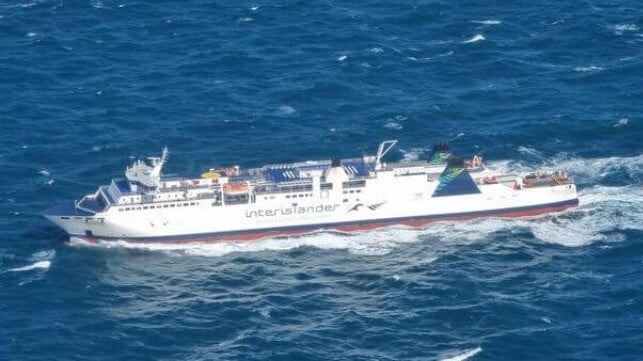New Zealand’s Troubled Interisland Ferry Aratere to Retire Early

After a troubled career spanning a quarter of a century, New Zealand’s workhorse RoRo ferry Aratere is set to retire in August. Operator KiwiRail is reporting that after being a familiar part of the Cook Strait crossing for 25 years, the ferry will be removed from service at the end of August, a decision necessitated by plans to carry out extensive infrastructure redevelopment in Picton. However, it will reduce the company’s capacity for possibly four years until new ferries can be introduced.
Having entered service in 1999, Aratere has been Interislander’s only rail-enabled ferry making 24 crossings on the Cook Strait route per week. The 184-meter (604-foot) ferry has a capacity of?600 passengers, 30 trucks or 230 cars, and 28 rail cars.
Originally, the ferry was built at a 150-meter (492-foot) length but underwent a NZ$52 million refit at the Sembawang shipyard in Singapore in 2011. The refit, which involved cutting the vessel in half to insert a new 30-meter (98-foot) midsection resulted in her capacity being increased from 360 to 600 passengers. Her gross tonnage increased from 12,595 tonnes to 17,816 tonnes.
Despite being synonymous with Cook Strait crossing for years, Aratere has had a troubled career characterized by several technical problems, engine failures, and a grounding in June last year. Over the years, the ferry has experienced at least eight major incidents, including a breakdown due to engine failure during its delivery run from its Spanish shipbuilder to New Zealand. Due to her troubled history, speculations have been rife that the ferry is jinxed, resulting in the nickname “El Lemon.”
The most frightening incident occurred on June 21 last year when Aratere grounded while departing Picton ostensibly because the crew did not know how to turn off the vessel’s autopilot when they realized she was heading towards the shore. The previous month, the vessel had received a new steering control system to work with the autopilot and integrated bridge navigation system. Investigators termed the grounding as a serious incident, but none of the 47 passengers and crew aboard were injured.
KiwiRail has now confirmed that Aratere will retire no later than August 30 to make way for infrastructure redevelopments in Picton in readiness for two new ferries that are expected to arrive in 2029. Apart from its troubled history, one of the other key factors in the ferry’s retirement is that she requires specific loading and unloading infrastructure, meaning she cannot use the other wharf in Picton. Building a temporary berth for her has been deemed too expensive and risks delaying the necessary infrastructure works. The government has previously stated that it would cost NZ$120 million to keep Aratere in service.
Demolition of Aratere’s wharf is expected to begin as soon as October this year, and no later than March next year to facilitate the construction of new infrastructure for the two new rail-enabled ferries planned by the New Zealand government. The replacement project however has been fraught with problems and cancelations causing controversy in New Zealand. The decision to acquire the new, identical ships was made after KiwiRail did an international search and failed to identify suitable second-hand ships to buy or lease. The company said it could not find vessels that would meet modern safety and environmental standards and the demands of the run.
The retirement of Aratere means that until the new ferries arrive in 2029, KiwiRail will be operating only two ferries on the Cook Strait route, Kaitaki and Kaiarahi. In late June, Kaiarahi is set to go to dry dock in Singapore for major works before returning to New Zealand in mid to late August. Although Aratere is currently Interislander’s only rail-enabled ferry, the operator will be able to carry rail freight on the other two ferries using a road bridging process.
KiwiRail has warned that the retirement of Aratere is bound to lead to job losses but is yet to determine the exact numbers. “Interislander’s transition from a three to two-ship fleet has a number of implications for the company and for our customers. The first impact is on our dedicated team and a formal consultation will begin with them,” said Duncan Roy, Interislander Executive General Manager.
